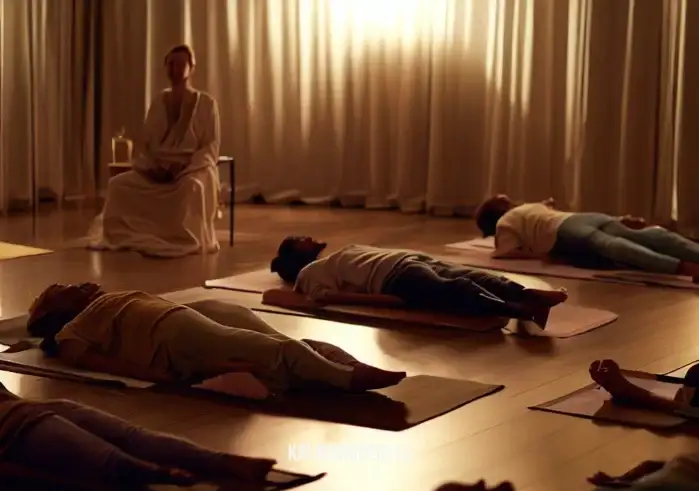Dive Into Deep Relaxation with Divine Sleep Yoga Nidra
In a world of constant motion and escalating stress, divine sleep yoga nidra offers a peaceful sanctuary for deep relaxation and inner healing. This ancient practice gently guides you into a state of profound calmness and clarity. With divine sleep yoga nidra, you can transform your life by embracing tranquility, a restful sleep, and harmony with your inner self.
Understanding Divine Sleep Yoga Nidra
Yoga nidra, often referred to as “yogic sleep,” is a form of guided meditation that leads you into a state of conscious deep sleep. One of the primary goals of yoga nidra is to induce complete physical, mental, and emotional relaxation.
“While in a state of relaxation, one appears to be asleep, but the consciousness is functioning at a deeper level of awareness.”
In this case, divine sleep yoga nidra incorporates a spiritual element, encouraging you to connect with your higher self and tap into your inner wisdom.
The Power of Divine Sleep Yoga Nidra
This unique practice goes beyond the confines of physical rest, giving you a transformative journey of self-exploration and self-discovery. But what makes divine sleep yoga nidra a truly invaluable tool?
- Deep Relaxation: By guiding you to a state of deep relaxation, divine sleep yoga nidra helps in alleviating stress and anxiety. The 30-minute guided meditation for anxiety can aid you in this relaxation process, creating a serene ambiance for you to unwind and let go of daily stressors.
- Restful Sleep: With regular practice, divine sleep yoga nidra can improve the quality of your sleep. The guided sleep meditation with music is a great resource to create an ideal environment for a peaceful slumber.
- Inner Healing: By facilitating a journey into your subconscious, divine sleep yoga nidra can assist you in releasing emotional blockages and promoting inner healing. It’s akin to the process of tapping for forgiveness, which focuses on letting go of past hurt and moving forward with grace and lightness.
Through divine sleep yoga nidra, you can experience a sense of balance, peace, and a profound understanding of yourself.
As we delve deeper into divine sleep yoga nidra, we’ll uncover more about its process, the steps involved in practicing it, and the incredible benefits it can offer you.
Please join us in the next part of the article where we will discuss how to practice divine sleep yoga nidra, how it connects with other practices like astral projection breathing technique, and how it can bring a meaningful change in your life.

How to Practice Divine Sleep Yoga Nidra for Inner Healing and Restful Sleep
Divine sleep yoga nidra is more than a practice; it’s an intimate journey into the self, a key to unlock your innate potential for deep relaxation, restful sleep, and inner healing. Now that we understand what this transformative practice entails, let’s delve into the ‘how’. Learning to practice divine sleep yoga nidra can usher in a wealth of wellness benefits.
A Step-by-Step Guide to Divine Sleep Yoga Nidra
Following a well-structured procedure can help make your divine sleep yoga nidra practice more effective. Here is a step-by-step guide to help you commence this journey:
- Set a Sankalpa: A Sankalpa, or intention, is a resolution you make before starting the practice. It’s akin to setting an affirmation during a body scan meditation for sleep. This intention is usually positive, simple, and framed in the present tense, such as “I am calm and relaxed.”
- Find a comfortable position: Divine sleep yoga nidra can be practiced lying down or in a comfortable seated position. Make sure you’re in a calm environment free from potential disturbances. Consider using props like a relaxation bed or a cushion to enhance your comfort.
- Practice mindful breathing: Begin by focusing on your breath. This is a grounding exercise that helps to relax your body and prepare your mind for the practice. It’s similar to the practice of left nostril breathing before sleep.
- Body awareness: Gradually shift your awareness to different parts of your body, starting from your toes and moving upwards. This is similar to the technique used in guided meditation lying down.
- Visualizations: At this stage, the guide may suggest various visualizations to deepen your state of relaxation. This could range from picturing a peaceful place to imagining a light traversing your body.
- Return to Sankalpa: As the practice comes to an end, you bring your awareness back to your intention. This reaffirmation of your Sankalpa helps in etching it into your subconscious mind.
A Glimpse into a Typical Divine Sleep Yoga Nidra Session
To give you a clearer picture, here’s a brief outline of what a typical divine sleep yoga nidra session may look like:
| Stages of Divine Sleep Yoga Nidra | Time Spent |
|---|---|
| Preparing for Practice | 5 minutes |
| Setting a Sankalpa | 5 minutes |
| Mindful Breathing | 10 minutes |
| Body Awareness | 15 minutes |
| Visualizations | 10 minutes |
| Return to Sankalpa | 5 minutes |
Remember that like any other practice, consistency is key. Regular practice of divine sleep yoga nidra can yield significant improvements in your sleep quality, stress levels, and overall well-being.
The beauty of divine sleep yoga nidra lies in its adaptability. It can be tailored to fit into your lifestyle, whether you have 15 minutes or 45 minutes to spare.
As we journey further into this enlightening practice, we invite you to join us in the next part of the article, where we will delve into the scientific evidence supporting divine sleep yoga nidra and explore how it intertwines with practices like Amethyst Sleeping.

The Power of Divine Sleep Yoga Nidra: Unpacking its Scientific Benefits
When it comes to the scientific benefits of divine sleep yoga nidra, the conversation goes far beyond restful sleep and deep relaxation. In fact, this practice can bring about remarkable improvements in various areas of our lives, from physical health to mental resilience. Let’s delve deeper into the scientific backing behind this powerful practice.
Health Benefits of Divine Sleep Yoga Nidra
“Sleep is the best meditation.” – Dalai Lama
The Dalai Lama’s words couldn’t be more fitting. A key component of divine sleep yoga nidra is its capacity to promote restful sleep, as exemplified in this guided meditation for deep sleep and relaxation. However, its benefits extend far beyond this realm. Here are some scientifically proven benefits of this practice:
- Reduces Stress and Anxiety: A consistent practice of divine sleep yoga nidra has been shown to decrease levels of cortisol, the body’s main stress hormone. It also enhances your body’s relaxation response, providing an antidote to the harmful effects of chronic stress and morning anxiety.
- Enhances Sleep Quality: By promoting a state of deep relaxation, divine sleep yoga nidra improves sleep quality, reduces sleep onset latency, and alleviates sleep disturbances. This is especially beneficial for those struggling with sleep disorders or insomnia, similar to the help received by insomnia recovery stories documented on our website.
- Promotes Emotional Healing: As Bessel van der Kolk once said, “The body keeps the score.” Trauma and emotional distress manifest in our physical bodies, leading to discomfort, pain, or illness. Divine sleep yoga nidra facilitates the release of these stored emotions, leading to profound inner healing. In this context, it can be seen as a form of detox for your heart.
- Boosts Concentration and Focus: By training the mind to maintain awareness while in a deeply relaxed state, divine sleep yoga nidra enhances concentration, focus, and cognitive performance. It’s like checking out your mind, as suggested in this article, but with the added benefit of relaxation and rejuvenation.
- Improves Physical Well-being: Divine sleep yoga nidra promotes relaxation of the autonomic nervous system, leading to reduced heart rate, lower blood pressure, and improved respiratory function. The impact is not dissimilar to the benefits of 285 Hz frequency, which is known for its healing effects.
“The greatest weapon against stress is our ability to choose one thought over another.” – William James
When we practice divine sleep yoga nidra, we’re not just opting for a quick fix to our problems. We’re choosing a transformative, healing journey towards a healthier, more resilient version of ourselves.
In the next part of our exploration of divine sleep yoga nidra, we will uncover the nuances of this practice and delve deeper into the realm of conscious sleep. From learning about the difference between conscious bedtime stories and sleep meditation, to understanding how we can program our mind while we sleep, there’s plenty of exciting information waiting for you. So, we cordially invite you to continue this enlightening journey with us. Stay tuned for part four!

The Nuances of Divine Sleep Yoga Nidra: A Journey into Conscious Sleep
As we continue our exploration of divine sleep yoga nidra, we now venture into the realm of conscious sleep, a cornerstone of this transformative practice. What does conscious sleep mean? How is it different from the sleep we experience every night? Let’s unravel the answers to these questions and more.
Understanding Conscious Sleep
“Don’t lose hope. When the sun goes down, the stars come out.” – Unknown
This quote beautifully illustrates the concept of conscious sleep in divine sleep yoga nidra. As we descend into the depths of restful slumber, our conscious awareness, like the stars, remains illuminating our inner world.
In divine sleep yoga nidra, we remain aware during the deepest states of relaxation and sleep. It’s a paradoxical state where we’re both asleep and awake, similar to the concept discussed in no sleep method shifting. This state offers a unique opportunity to tap into the subconscious mind, leading to profound insights and transformation.
The Conscious Sleep Matrix
Understanding the stages of consciousness in divine sleep yoga nidra can provide a clearer picture of the journey you’ll embark on during the practice. Let’s explore this in the following table:
| Stage | Description |
|---|---|
| Waking State | In this state, you’re fully alert and conscious of your surroundings. Your attention is typically external, focused on the world around you. |
| Dream State | Here, your consciousness transitions to the internal realm, filled with dreams and imagery. This state is often compared to night time meditation for love, as the dream state can be filled with profound emotional content. |
| Deep Sleep State | This is a state of complete unconsciousness. It’s the realm of deep, restorative sleep, where both the mind and body rejuvenate. However, with divine sleep yoga nidra, we maintain an element of consciousness even in this state. |
| Transcendent State | This is the ultimate goal of divine sleep yoga nidra. It’s a state where you transcend normal consciousness to experience a state of oneness and wholeness. It’s similar to what’s experienced during astral projection breathing techniques. |
“The best way to predict your future is to create it.” – Abraham Lincoln
Through divine sleep yoga nidra, you can create a brighter, healthier future for yourself by exploring and transforming your inner world. It’s like gently stepping into a space for anxiety, allowing for a peaceful resolution of your anxieties and fears.
As we wrap up this segment of our journey into divine sleep yoga nidra, we invite you to continue exploring this fascinating practice with us. The final chapter of this article will delve deeper into how you can incorporate divine sleep yoga nidra into your daily life and some common challenges beginners might face. From exploring guided sleep meditation mindful movement to addressing the question why you should not meditate at night, we’ll provide comprehensive guidance to aid your journey towards inner healing and transformation. Let’s continue this enlightening journey together!

Making Divine Sleep Yoga Nidra a Part of Your Daily Life: Tips and Challenges
This concluding section of our journey into divine sleep yoga nidra seeks to equip you with practical tips to make this transformative practice a part of your daily life. We will also address some common challenges that beginners may face and offer insights on how to navigate them.
Starting Your Divine Sleep Yoga Nidra Practice
Set a schedule: Incorporating divine sleep yoga nidra into your daily routine requires consistency. Just like morning anxiety meditation, the benefits of divine sleep yoga nidra are more pronounced with regular practice. Decide on a specific time each day when you can commit to this practice. Some prefer mornings, while others find evenings more suitable.
Create a calming environment: Your surroundings play a vital role in your practice. A tranquil space fosters a relaxing atmosphere, similar to what you may find in boho meditation sleep. Comfort is key, so ensure you have a soft mat or bed to lie on during the practice.
Use guided resources: Especially for beginners, guided practices can be incredibly helpful. Explore resources like guided meditation lying down or guided meditation for deep sleep and relaxation to aid your practice.
Set an intention: Before you begin your practice, setting an intention can enhance the experience. This is akin to practicing emotional turbulence meditation, where a focused intention can bring about meaningful change.
Overcoming Challenges in Your Practice
Just like any other new practice, divine sleep yoga nidra can present certain challenges. Here’s how you can address them:
Falling asleep: It’s common for beginners to fall asleep during the practice. If you find this happening, don’t worry. It’s an indication that your body needs rest. You may also explore insomnia recovery stories for additional insights.
Distractions: External noises or thoughts can sometimes interfere with your practice. Regular practice and using tools like soothing alarm sounds can help manage distractions.
Discomfort: Physical discomfort can arise if you’re not used to staying still for extended periods. Use cushions and blankets for support and comfort.
Emotional upheavals: Divine sleep yoga nidra can sometimes bring up strong emotions or memories. Remember, this is a part of the healing process. Techniques like tapping for forgiveness can provide additional support during such times.
“The secret of change is to focus all of your energy, not on fighting the old, but on building the new.” – Socrates
As we end this exploration into divine sleep yoga nidra, remember that this practice, much like a ritual meditation, is a journey, not a destination. With patience, persistence, and compassion, you can cultivate a deep sense of relaxation, restful sleep, and inner healing.
This immersive journey into divine sleep yoga nidra, from its origins to its practical application, offers you the tools to navigate your path towards holistic wellness. Embark on this journey of self-discovery, transformation, and healing, and awaken to the infinite possibilities within you.
In the realm of divine sleep yoga nidra, restful sleep and awakened consciousness are not at opposite ends but dance together harmoniously, leading you towards inner tranquility and outer vitality. Let the dance begin.

Conclusion: The Transformative Power of Divine Sleep Yoga Nidra
As we wind down this comprehensive guide to divine sleep yoga nidra, we reflect upon the profound journey we’ve undertaken together. This ancient practice holds the key to unlocking a wealth of wellness benefits, allowing us to harness the restorative power of deep relaxation, restful sleep, and inner healing.
Consider the practice of meditation for pain relief and sleep. Just as this technique provides relief from physical discomfort and aids in restful sleep, divine sleep yoga nidra is a salve for the mind, body, and spirit. This age-old practice dissolves tension, allowing you to journey deep within, tapping into your subconscious mind.
Practicing divine sleep yoga nidra is akin to exploring the in-between space – that tranquil threshold between wakefulness and sleep where you can access deep healing and transformation. It is the check out your mind experience of surrendering control and allowing yourself to flow with the river of consciousness.
The path to inner peace and well-being does not stop here. Continue to explore the wealth of resources available to support your wellness journey. Dive into the intricacies of astral projection breathing technique, or indulge in the calming practice of 40-minute guided meditation.
Just as relaxation-driven meaning proposes, let your pursuit of wellness be driven by a desire for deep relaxation and inner tranquility. The practices and techniques shared here serve as stepping stones on your path to holistic well-being.
“Peace comes from within. Do not seek it without.” – Buddha
The practice of divine sleep yoga nidra is a powerful tool in your wellness arsenal. Yet, this is just one of many paths to well-being. Continue to explore, learn, and grow with our collections and blog posts that cover a broad range of topics related to wellness, healing, and personal development.
In conclusion, divine sleep yoga nidra is more than a practice – it’s a way of life. Embrace it, embody it, and let it guide you towards deep relaxation, restful sleep, and inner healing.
Remember, your wellness journey does not end here. Keep exploring, keep learning, and keep growing. May your path be filled with peace, light, and well-being.
Thank you for joining us on this journey. We invite you to continue exploring our wealth of resources and broadening your understanding of the vast world of wellness. Let your curiosity guide you, and may you find what you seek. Until next time, namaste.





